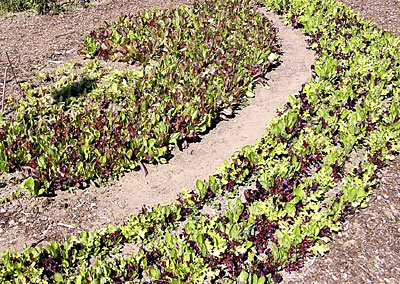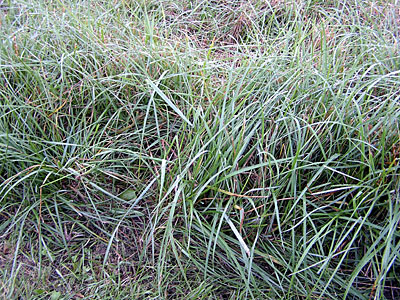 |
| Homemade lettuce seed mix. English photo. |
Custom Lettuce Seed Mix
Managing Blight on Tomatoes
Seeking Rare Ladybugs
Controlling Fruit Flies in the Home
The Recycled Garden
Goats and Cattle Graze Together
Mechanical Methods Reduce Weed Seedbank
Rolling and Crimping Cover Crops
Festulolium Rotation?
Make Your Own Custom Lettuce Seed Mix
If you have several packets of old lettuce seed, you can combine them and the results could look something like this colorful section of the Peace Sign Garden that Mount View High School’s Peace Jam group has established at MOFGA’s Trial Gardens in Unity.
– Jack Kertesz, Unity, Maine
Managing Blight on Tomatoes
© 2008 Adam Tomash
Early and late blights caused heavy mortality of tomato plants due to Maine’s extremely long wet spells over the 2008 summer. Yields were much reduced and sometimes nonexistent. Even very experienced gardeners had problems.
Using the following method, we saw little blight of consequence until mid-September, and yields were substantial.
3. If you use homemade compost, avoid putting tomato (or any nightshade) refuse in the compost. Bury it instead. We use only worm castings (tomato free) and minerals for fertilizer. Compost that has heated thoroughly might work, but few backyard compost piles get hot enough. Also, if you give plants too much nitrogen, you will get lush foliage but much less fruit.
4. Immediately after planting, mulch plants well to protect them from blight-infected soil splashing onto them during rains. We use straw or hay; plastic may work but I prefer natural materials.
5. The day of transplanting, drench the roots of each plant with a cup of Rootshield® (from Fedco/Organic Growers’ Supply) solution made according to directions on the package. Treating 100 plants will cost about $14. Within a few days, apply another cup of root drench solution to each plant. A constant source of moisture, such as drip irrigation, also reduces plant stress, making them less susceptible to blight.
6. Keep plants pruned and tied to the trellis as they grow. If you have a lot of plants to trellis, invest in a hand-trellising machine, such as Ty-m-Up® from Johnny’s or MaxTapener from A.M. Leonard, to speed the process. Practice sanitation with the prunings: Bury them or bring them to the transfer station. Prune any plants that show disease last to avoid spreading the disease.
7. As the season progresses, some disease will appear on lower leaves. Remove and bury those leaves to slow the spread of the disease. Use rubber gloves or wash your hands before touching any other nightshades. (Tobacco is a nightshade, so if you smoke, wash your hands before handling any tomato plants at any stage of growth, even the seeds.)
Seeking Rare Ladybugs
Agricultural Research Service (ARS) scientists and cooperators are seeking the public’s help in surveying for once-common ladybug species that are now hard to find. Researchers with ARS, Cornell University and South Dakota State University want people to send photographs of ladybugs to Cornell so that researchers can inventory the insects. The scientists are looking for rare species, such as the nine-spotted, two-spotted and transverse lady beetles, which were common 20 years ago but are now harder to find. More than 400 ladybug species are native to North America, but some have become extremely rare, displaced perhaps by development, pesticides, non-native species and other factors. In a survey last summer, Hesler and a colleague found 1,000 ladybugs, but only about 10 each of the three rare species. Visit www.lostladybug.org for more information. (USDA Agricultural Research Service News Service, Sept. 18, 2008; www.ars.usda.gov/is/pr)
Controlling Fruit Flies in the Home
© 2008 Adam Tomash
When our homes fill with the bountiful harvest of tomatoes, melons and tree fruit in late summer and in fall, large populations of fruit flies become very noticeable, quickly covering any piece of fruit left out. An easy way to control their numbers is to place a piece of fruit, such as melon, apple or tomato, on a shallow saucer and cover it with a thin film of clear food wrap. The clingy stuff works best. Then make three slits in the plastic with a sharp knife. These portals allow the flies to enter, but they become trapped inside and cannot escape easily. When the trap becomes loaded with flies, take it outside and release or otherwise dispose of them. Make a new trap with fresh fruit and clean plastic. This crude method limits fruit fly numbers to manageable levels.
The Recycled Garden
I’ve always had a notion to try pallet culture, since the durable structures are readily available and usually free, so I wrapped one in another salvaged material – silt fence – filled the space with old compost and grew cucumbers in it at MOFGA’s Trial Gardens in Unity. Most construction sites require this soil stabilizing silt fence to be in place for a year; after that it can sometimes be appropriated. Part of my impetus to concoct something like this was Eliot Coleman’s observation that a south facing slope absorbs sunlight in correlation to the angle of its slope. Increasing the slope is like owning real estate farther south. I started this project late last summer. The plants emerged and grew slowly, and the pallet garden dried out fairly quickly, so the plants did not do well. Having a tilted planting surface like this is probably more appropriate in the spring, in a less windy site, with different crops and a better soil mix. Perhaps you’ll experiment on your own. (Ed. note: How about putting four such pallets together to make a compost bin, with the covered pallets creating a vertical garden around the bin?)
– Jack Kertesz, Unity, Maine
Top
Goats and Cattle Graze Together
University of Kentucky agriculture specialists and an Eastern Kentucky farmer are testing a mix of cattle and goats or goats following cattle in paddocks to graze pastures of tall fescue, orchardgrass, clovers and weeds. After one grazing season, cattle grazing with goats weighed a mean of 30 pounds more than cattle that followed goats. Goats in both groups thrived, since they feed on a greater diversity of plants, including many that cattle don’t eat. The goats helped control multifora rose and tall ironweed. By their third year on the farm, goats had eliminated almost all multiflora rose. Challenges included providing water for the animals; fencing the goats; and teaching goats to move from one paddock to another. (“East Kentucky Project Pairs Cattle with Goats for Co-Grazing Research,” Kentucky Ag Connection, Aug. 8, 2008, www.kentuckyagconnection.com/story-state.php?Id=577&yr=2008)
Mechanical Methods Reduce Weed Seedbank
A study in Weed Science reports that weed seed destruction and predation are practical alternatives to the use of herbicides to manage weeds. Because persistent weed seeds survive longer than their next vegetation period, unlike transient weed seeds, their management must address the problems associated with seed dormancy.
Scientists analyzed chemical and physical methods of defense in six weed species common in grain crop production fields in the Midwest. After measuring chemical concentrations of phenol and applying four types of physical damage to each species, the researchers discovered, surprisingly, that as seed persistence increased, chemical protection decreased. Also, just a small amount of damage destroyed highly persistent weed seeds, because their chemical defenses couldn’t protect them from opportunistic fungi and bacteria.
The researchers suggest revisiting the use of harvest machinery that collects and slightly damages weed seeds – an approach used before the days of herbicides. They also suggest ensuring that predispersal predators, such as arthropods, are present to consume weed seeds or to pierce their coats, which would encourage microbial predation of the seeds. (Weed Science Soc. of Amer. press release, Sept. 8, 2008; www.wssa.net/. The study appears at www.allenpress.com/pdf/WEES-56-5-676.pdf)
Rolling and Crimping Cover Crops
Rolling hay, rye and other cover crops with rolling machines that can quickly flatten mature, high-biomass cover crops could be the fastest way for some farmers to prepare fields for planting. Each roller consists of a long cylinder with thick, blunt, steel crimping bars, each about 1/4-inch thick. As a standard tractor pulls the roller over the field, pressure from the bars flattens and damages the cover crop without cutting or uprooting it. Within three weeks, the rolled crop dries and forms a mat of dead biomass into which farmers can plant cash crops.
Scientists at the National Soil Dynamics Laboratory in Auburn, Ala., compared three roller designs: a traditional design with long, straight, horizontal bars; diagonal bars that curve around the roller; and a smooth drum attached to a crimping bar that mashes rye as the machine moves forward. All three killed enough rye – 90% or more – to enable farmers to begin planting cash crops in the field within three weeks (in the Southeast). The crimping-bar roller yielded the best results. The curved-bar and the crimping rollers provided smoother rides than the traditional straight-bar roller.
The one-pass process saves money, reduces soil erosion and runoff, helps control weeds, conserves soil water and decreases or eliminates the need for herbicides. (USDA Agricultural Research Service News Service,
Laura McGinnis, Sept. 3, 2008, Agricultural Research, www.ars.usda.gov/is/pr)
 |
| Festulolium is a fine cover crop for Maine gardens. English photo. |
Festulolium, a cross between festucas (meadow fescue/tall fescue) and lolium (Italian ryegrass), is one of the finest cover crops I have ever grown. It was easy to establish, aggressive enough to outcompete weeds in its early stages and tenacious enough to survive the winter. Planted in late August 2006 at MOFGA’s Trial Gardens in Unity, it was mowed several times in 2007 and 2008. It might be just the ticket to take portions of a garden out of production as part of a rotation. Seed is available from Fedco.
– Jack Kertesz, Unity, Maine
